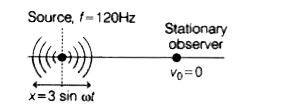An observer and a source emitting sound of frequency 120 Hz are the X-axis . The observer is stationary while the source of sound is in motion given by the equation x=3 sin ω (x is in metres and t is in seconds). If the diffrence between the maximum and minimum frequencies of the sound observed by the observers is 22Hz , then the value of ω is (speed of sound in air = 330 ms−1Solution in Telugu
33 rad s−1
36 rad s−1
20 rad s−1
10 rad s−1
The correct Answer is:D

Instantaneous speed of source is v=dxdt=2ωsinωt
Difference between maximum and minimum frequencies is 22 Hz.
So fmax−fmin=f(vv−vs)−f(vv+vs)=22
⇒f{vv−vs−vv+vs}=22
Now here , f= 120 Hz, v = 330 ms−1vs=3ω
Substituting these values in Eq (i) , we get 120(330330−3ω−330330+3ω)=22⇒ω=10s−1
Topper's Solved these Questions
Similar Questions
A nucleus of deuterons or deuterium is a bound atomic system best described by
View SolutionThe pressure on a circular plate is measured by measuring the force on the plate and the radius of the plate. If the errors in measurement of the force and the radius are 5% and 3% respectively, the percentage of error in the measurement of pressure is
View SolutionAn observer moves towards a stationary source of sound with a speed (15)th of the speed of sound. The wavelength and frequency of the source emitted are λ and f, respectively. The apparent frequency and wavelength recorded by the observer are, respectively.
View SolutionA source of sound is travelling towards a stationary observer. The frequency of sound heard by the observer is 25% more than the actual frequency. If the speed of sound is v, that of the source is
View SolutionA source of sound of frequency 90 vibrations/ sec is approaching a stationary observer with a speed equal to 1/10 the speed of sound. What will be the frequency heard by the observer
View Solutionएक स्रोत और एक प्रेक्षक एक-दूसरे की ओर वेग V/2 से आ रहे हैं, जहाँ V ध्वनि की चाल है। स्रोत की आवृत्ति n है तो प्रेक्षक द्वारा सुनी हुई ध्वनि की आवृत्ति का मान होगा :
View SolutionA sound source, emitting sound of constant frequency, moves with a constant speed and crosses a stationary observer. The frequency (n) of sound heard by the observer is plotted against time (t). Which of the following graphs represents the correct variation :-
View SolutionAn observer approaches a stationary sound source 1000 Hz at twice the speed of sound. What frequency does the observer hear?
View SolutionA source of sound is travelling towards a stationary observer. The frequency of sound heard by the observer is 25% more that the actual frequency. If the speed of sound is v, that of the source is
View SolutionAn observer moves towards a stationary source of sound with a speed 1//5^(th) of the speed of sound. The wavelength and frequency of the source emitted are X and f respectively. The apparent frequency and wavelength recorded by the observer are respectively
View SolutionAn observer moves towards a stationary source of sound with a speed (15)th of the speed of sound. The wavelength and frequency of the source emitted are λ and f, respectively. The apparent frequency and wavelength recorded by the observer are, respectively.
View SolutionTo an observer moving towards a stationary source, the frequency of sound appears to be twice its original frequency. If the speed of sound is v, then the speed of the observer will be
View SolutionA source of sound is travelling towards a stationary observer. The frequency of sound heard by the observer is three times the original frequency. The velocity of sound is v. the speed of source will be
View SolutionA source of sound is travelling towards a stationary observer. The frequency of sound heard by the observer is 25% more than the actual frequency. If the speed of sound is v, then that of the source is
View SolutionA sound source, emitting sound of constant frequency, moves with a constant speed and crosses a stationary observer. The frequency (n) of sound heard by the observer is plotted against time (t). Which of the following graphs represents the correct variation :-
View Solution
